
Paranormal Essex is written by David Scanlan of the Hampshire Ghost Club (his involvement some way from his home turf is not explained) and Paul Robins of Essex Paranormal. It starts with advice on spontaneous case investigation, discussing equipment but not, as some groups do, fetishising it. Most of the forty location entries, listed alphabetically, are quite short, so this is a fairly brisk read despite the number of places included. More space is devoted to Borley Rectory and Matthew Hopkins, though even these entries are briefish, and tread well-worn ground. The most interesting sections are those detailing investigations by paranormal groups, such as at Coalhouse Fort, the Red Lion Hotel in Colchester, and the, er, Kelvedon Hatch Nuclear Bunker; or those containing witness statements. The blurb claims that the book explores “in depth, the complete range of paranormal phenomena reported throughout Essex.” But it is fair to say that it does not live up to that promise.
Unlike the authors of Paranormal Essex, Dee Gordon is not a paranormal investigator, but is a professional writer mainly specialising in Essex history. A Southend resident, she is well placed to write about its paranormal side, and has been assiduous in combing newspaper accounts and talking to locals. The book takes in a larger area than just Southend, covering places like Leigh-on-Sea, Westcliff and Shoeburyness as well as some of the local villages. While she has packed in a lot of locations, navigating her text is not made easy for the casual reader. The contents are divided into: haunted houses; churches and rectories; commercial buildings; open spaces; watering holes (ie pubs, hotels and restaurants); unlikely haunted locations (really a few cases hard to fit into the categories employed); and phantom dogs. Looking for a specific place requires some thumbing (the pier, for example falls under haunted houses), limiting its use as a guidebook. For the armchair reader, though, it is an enjoyable tour of the Southend area.

